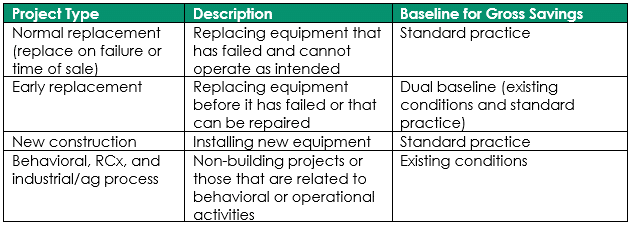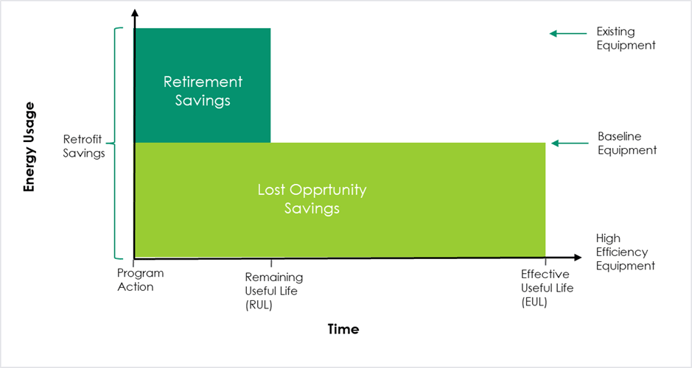Baselines!
“Baseline” is an incredibly important term in energy efficiency evaluation. It is thrown around often in many different contexts. So what does it mean? Michaels Energy is currently conducting several baseline studies, but when describing these studies to others, I realized that baselines and their related research can have many different meanings, each with important distinctions. Let’s jump into the deep end of energy efficiency wonkiness.
At the most basic level, baselines represent the status quo against which interventions (e.g., new equipment, new policies, etc.) are measured. In energy efficiency, any discussion about baselines begins with whether we are talking about what is already installed (the market baseline) and what is being used to calculate energy savings (the standard practice and existing conditions baselines).[1]
Market Baselines
If you are looking to understand the current state of your market and the existing equipment or practices already implemented, then you are looking at the market baseline. Michaels has worked or is currently working on a number of large market baseline studies around the country. These studies typically determine the current level of efficiency in the market through surveys and site visits of a representative sample of hundreds or thousands of homes and businesses.[2] These studies often estimate the penetration (the share of homes or businesses with the equipment) and saturation (the average number of pieces of equipment among all homes or businesses in the study) of energy efficient equipment but can investigate other metrics as well.
Program administrators can use information from market baseline studies to determine which types of equipment should be targeted by energy efficiency programs. Equipment types with very high penetration (such as LEDs) may receive less focus (and ratepayer dollars) than those with lower penetration (such as heat pump water heaters). This information is also very useful for a variety of other stakeholders and is often used as a key input for potential studies and to establish baselines for market transformation programs. Due to the large amount of primary data collection and analysis required, these studies tend to be costly, making statewide studies that cover multiple utilities very appealing.
Baselines for Calculating Energy Savings
Energy savings are determined by calculating the difference between the energy consumption of the energy-efficient measure and what would have occurred if the measure had not been implemented. To quantify savings, we must compare the efficient option to the appropriate baseline. The table below shows the appropriate baseline for different project types.

Note that energy use baselines are also incredibly important, but today we are just covering equipment baselines.
Standard Practice Baseline
For measures that are replacing failed equipment or are used in new construction or capacity expansion, savings should be calculated using a Standard Practice Baseline. This approach is used for time of sales initiatives (and can be upstream, midstream, or downstream programs) where the program is designed to influence the efficiency of a product that was already going to be purchased and a common and readily-available replacement solution exists.
The Standard Practice Baseline is an estimate of the equipment installation or practice that would take place absent the energy efficiency program. In many cases, the baseline is the equipment/solution that is minimally compliant with local code.[3] If there are no legal minimums, then the baseline is the least efficient product commonly purchased solution.
To determine the appropriate standard practice baseline, evaluators should conduct an industry standard practice (ISP) study investigating current trends in the purchase and installation of the equipment in question. The CPUC has established a handy guide to provide guidance on ISP studies. Notably, ISP studies often are smaller scale than market baseline studies discussed earlier. According to the CPUC, “the methodology used in an ISP study may not always result in statistically significant measurements of the current market purchase, installation, or practice trends. The study should collect data and information to make an informed decision about an ISP determination.” Michaels is currently conducting some ISP studies that rely on interviews with manufacturers, distributors, and contractors, as well as literature reviews. It is much more cost effective to gather “top down” information about industry trends and practices from these market actors rather than attempting to identify and survey customers who have purchased the equipment. Other ISP studies, particularly related to new construction, may use focus groups or Delphi panels to estimate industry standard practices.
For custom projects, a full ISP study will not be applicable because of the lack of a common and readily available solution and the evaluator will need to do informal custom ISP research. This would entail interviewing the customer and researching a selection of vendors to understand the current purchase trends of the technology being replaced/installed.
Existing Conditions Baseline
For operations and behavioral measures or equipment used in non-building projects (e.g., industrial or agricultural processes), energy savings should be calculated comparing the efficient option with the efficiency level of the equipment or construction in place before the energy efficiency intervention.
Dual Baseline
Some measures require a dual baseline approach, such as early replacement measures which replace equipment that is still functional. Calculating lifetime savings for these measures requires using two baseline periods. The first period (the retirement savings) uses the existing equipment as the baseline and lasts until the end of the remaining useful life of the existing equipment (i.e., the difference between the equipment’s current age and its expected age of failure or removal). The second period (the lost opportunity savings) assumes a code or industry standard practice as the baseline and continues until the last year of the measure’s effective useful life (EUL)[4]. The total lifetime savings is the sum of the savings from these two periods, as illustrated below.

Adapted from Connecticut’s 2022 Program Savings Document, Chart A4-1
In addition to early replacement scenarios, some measures may require a dual baseline approach to account for planned changes in standards. For example, increases in the efficiency standards of some lighting and furnace measures in the past decade have required the use of two baselines to account for the increased efficiency of the standard practice baseline during the life of the equipment.
Other Considerations
Using the appropriate baseline for different installation scenarios is very important when calculating energy savings, but it is critical for other elements of evaluation as well. When calculating cost effectiveness, the cost of the equipment considered in the test may depend on the baseline. Additionally, a program’s savings attribution, or net-to-gross, is tied to its baseline so that the appropriate decision processes are considered.
[1] This does not cover energy use baselines, which we will save for another time.
[2] Market baseline studies usually have large sample sizes to ensure a mix of homes or businesses of various sizes, types, and geographies, all of which may affect what equipment is installed and how it is used.
[3] Note that even if there is an applicable code, the standard practice baseline may be higher than the code minimum if the technology or practice is adopted faster than updates to code. It also may be lower, if code compliance is lacking.
[4] Effective useful life is defined as the median number of years between the installation of a piece of equipment and its failure or removal.

